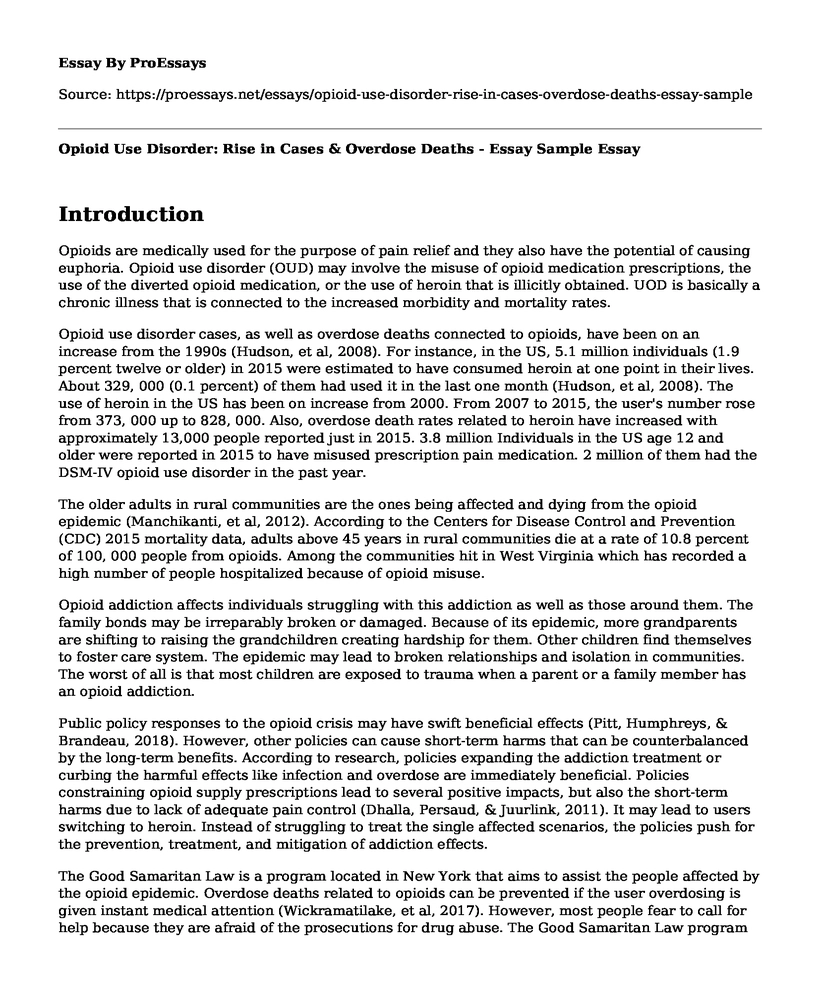Introduction
Opioids are medically used for the purpose of pain relief and they also have the potential of causing euphoria. Opioid use disorder (OUD) may involve the misuse of opioid medication prescriptions, the use of the diverted opioid medication, or the use of heroin that is illicitly obtained. UOD is basically a chronic illness that is connected to the increased morbidity and mortality rates.
Opioid use disorder cases, as well as overdose deaths connected to opioids, have been on an increase from the 1990s (Hudson, et al, 2008). For instance, in the US, 5.1 million individuals (1.9 percent twelve or older) in 2015 were estimated to have consumed heroin at one point in their lives. About 329, 000 (0.1 percent) of them had used it in the last one month (Hudson, et al, 2008). The use of heroin in the US has been on increase from 2000. From 2007 to 2015, the user's number rose from 373, 000 up to 828, 000. Also, overdose death rates related to heroin have increased with approximately 13,000 people reported just in 2015. 3.8 million Individuals in the US age 12 and older were reported in 2015 to have misused prescription pain medication. 2 million of them had the DSM-IV opioid use disorder in the past year.
The older adults in rural communities are the ones being affected and dying from the opioid epidemic (Manchikanti, et al, 2012). According to the Centers for Disease Control and Prevention (CDC) 2015 mortality data, adults above 45 years in rural communities die at a rate of 10.8 percent of 100, 000 people from opioids. Among the communities hit in West Virginia which has recorded a high number of people hospitalized because of opioid misuse.
Opioid addiction affects individuals struggling with this addiction as well as those around them. The family bonds may be irreparably broken or damaged. Because of its epidemic, more grandparents are shifting to raising the grandchildren creating hardship for them. Other children find themselves to foster care system. The epidemic may lead to broken relationships and isolation in communities. The worst of all is that most children are exposed to trauma when a parent or a family member has an opioid addiction.
Public policy responses to the opioid crisis may have swift beneficial effects (Pitt, Humphreys, & Brandeau, 2018). However, other policies can cause short-term harms that can be counterbalanced by the long-term benefits. According to research, policies expanding the addiction treatment or curbing the harmful effects like infection and overdose are immediately beneficial. Policies constraining opioid supply prescriptions lead to several positive impacts, but also the short-term harms due to lack of adequate pain control (Dhalla, Persaud, & Juurlink, 2011). It may lead to users switching to heroin. Instead of struggling to treat the single affected scenarios, the policies push for the prevention, treatment, and mitigation of addiction effects.
The Good Samaritan Law is a program located in New York that aims to assist the people affected by the opioid epidemic. Overdose deaths related to opioids can be prevented if the user overdosing is given instant medical attention (Wickramatilake, et al, 2017). However, most people fear to call for help because they are afraid of the prosecutions for drug abuse. The Good Samaritan Law program is available to protect the victims in such circumstances. They also provide naloxone training to the affected users. Naloxone is a kind of medication that reverses opioid overdoses like prescription pain killers and heroin (Kim, Irwin, & Khoshnood, 2009). Since naloxone was legalized in New York State in the year 2006, it has become a very important tool in fighting and prevention deadly drug overdoses. The institution has different programs that vary by age. The program also teachers those who have recovered from the opioid epidemic on how to help people who are at a high risk of opioid use disorder and overdose as well as those who are already affected and are struggling with the problem.
Works Cited
Hudson, T. J., Edlund, M. J., Steffick, D. E., Tripathi, S. P., & Sullivan, M. D. (2008). Epidemiology of regular prescribed opioid use: results from a national, population-based survey. Journal of pain and symptom management, 36(3), 280-288.
Manchikanti, L., Fellows, B., Janata, J. W., Pampati, V., Grider, J. S., & Boswell, M. V. (2012). Opioid epidemic in the United States. Pain physician, 15(3 Suppl), ES9-38.
Kim, D., Irwin, K. S., & Khoshnood, K. (2009). Expanded access to naloxone: options for critical response to the epidemic of opioid overdose mortality. American journal of public health, 99(3), 402-407.
Pitt, A. L., Humphreys, K., & Brandeau, M. L. (2018). Modeling health benefits and harms of public policy responses to the US opioid epidemic. American journal of public health, 108(10), 1394-1400.
Dhalla, I. A., Persaud, N., & Juurlink, D. N. (2011). Facing up to the prescription opioid crisis. Bmj, 343, d5142.
Wickramatilake, S., Zur, J., Mulvaney-Day, N., Klimo, M. C. V., Selmi, E., & Harwood, H. (2017). How states are tackling the opioid crisis. Public Health Reports, 132(2), 171-179.
Cite this page
Opioid Use Disorder: Rise in Cases & Overdose Deaths - Essay Sample. (2023, Mar 21). Retrieved from https://proessays.net/essays/opioid-use-disorder-rise-in-cases-overdose-deaths-essay-sample
If you are the original author of this essay and no longer wish to have it published on the ProEssays website, please click below to request its removal:
- Public Policy on Health Essay
- Extreme Measures (film, 1996), pp. 263-265
- Gastrointestinal Case Study Paper Example
- EHR: Revolutionizing Healthcare Through Access, Safety, and Satisfaction - Essay Sample
- Nursing Informatics: The Paradigm Shift in Health Care Management - Essay Sample
- Essay Example on COVID-19: Impact of Human Activities on Climate Change
- Home Office During the COVID Era - Essay Example







